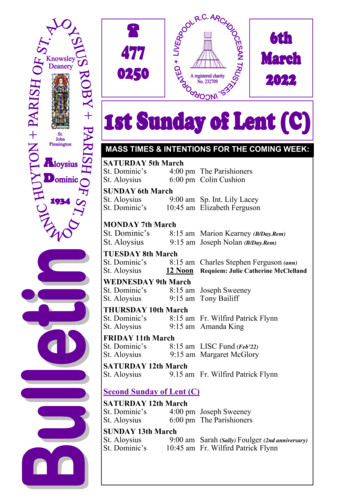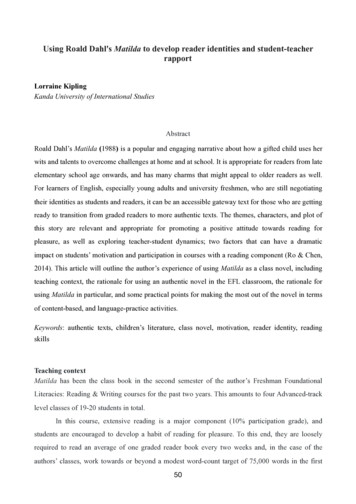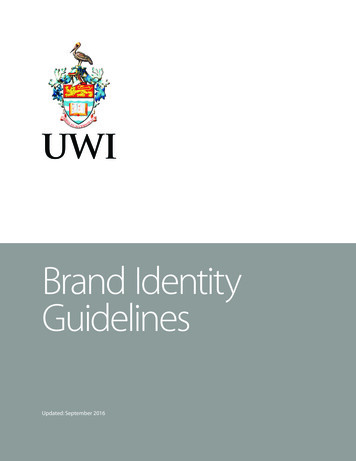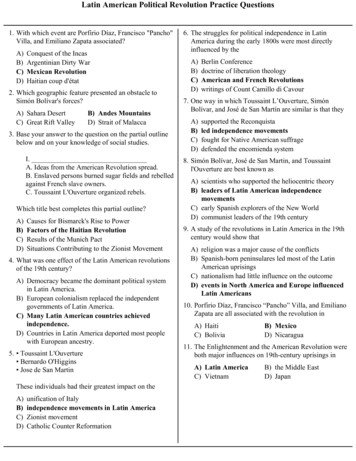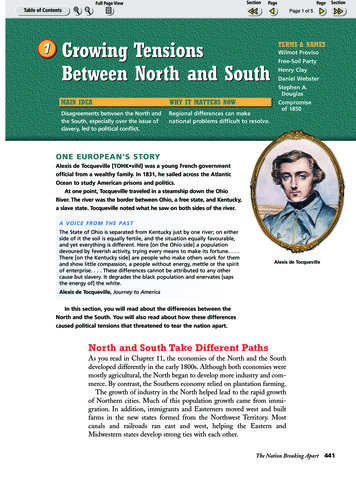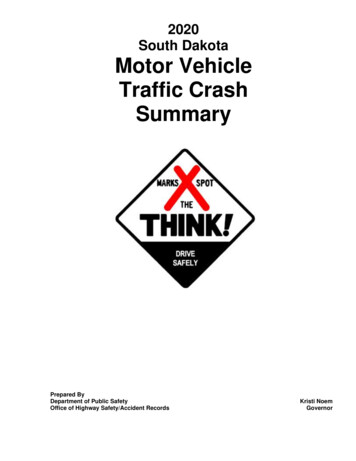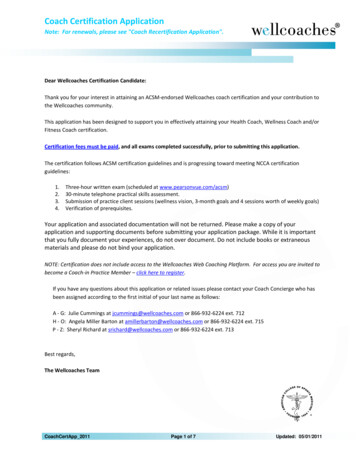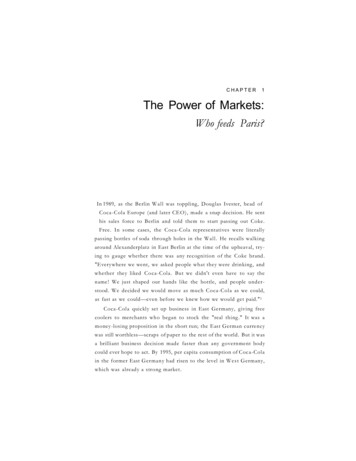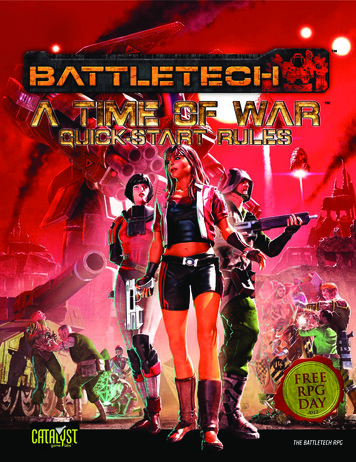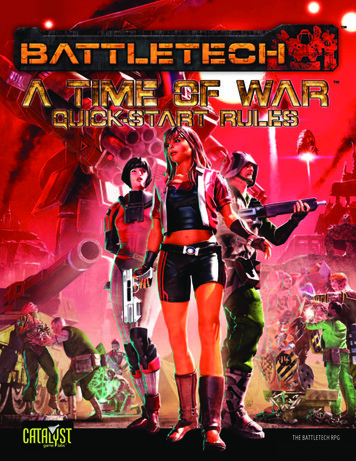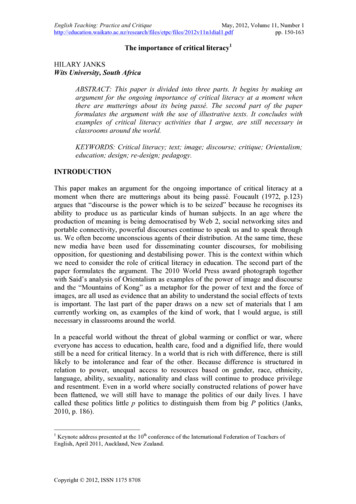
Transcription
English Teaching: Practice and CritiqueMay, 2012, Volume 11, Number c/files/2012v11n1dial1.pdfpp. 150-163The importance of critical literacy1HILARY JANKSWits University, South AfricaABSTRACT: This paper is divided into three parts. It begins by making anargument for the ongoing importance of critical literacy at a moment whenthere are mutterings about its being passé. The second part of the paperformulates the argument with the use of illustrative texts. It concludes withexamples of critical literacy activities that I argue, are still necessary inclassrooms around the world.KEYWORDS: Critical literacy; text; image; discourse; critique; Orientalism;education; design; re-design; pedagogy.INTRODUCTIONThis paper makes an argument for the ongoing importance of critical literacy at amoment when there are mutterings about its being passé. Foucault (1972, p.123)argues that “discourse is the power which is to be seized” because he recognises itsability to produce us as particular kinds of human subjects. In an age where theproduction of meaning is being democratised by Web 2, social networking sites andportable connectivity, powerful discourses continue to speak us and to speak throughus. We often become unconscious agents of their distribution. At the same time, thesenew media have been used for disseminating counter discourses, for mobilisingopposition, for questioning and destabilising power. This is the context within whichwe need to consider the role of critical literacy in education. The second part of thepaper formulates the argument. The 2010 World Press award photograph togetherwith Said’s analysis of Orientalism as examples of the power of image and discourseand the “Mountains of Kong” as a metaphor for the power of text and the force ofimages, are all used as evidence that an ability to understand the social effects of textsis important. The last part of the paper draws on a new set of materials that I amcurrently working on, as examples of the kind of work, that I would argue, is stillnecessary in classrooms around the world.In a peaceful world without the threat of global warming or conflict or war, whereeveryone has access to education, health care, food and a dignified life, there wouldstill be a need for critical literacy. In a world that is rich with difference, there is stilllikely to be intolerance and fear of the other. Because difference is structured inrelation to power, unequal access to resources based on gender, race, ethnicity,language, ability, sexuality, nationality and class will continue to produce privilegeand resentment. Even in a world where socially constructed relations of power havebeen flattened, we will still have to manage the politics of our daily lives. I havecalled these politics little p politics to distinguish them from big P politics (Janks,2010, p. 186).1Keynote address presented at the 10th conference of the International Federation of Teachers ofEnglish, April 2011, Auckland, New Zealand.Copyright 2012, ISSN 1175 8708
H. JanksThe importance of critical literacyPolitics with a capital P is about government and world trade agreements and theUnited Nations’ peace-keeping forces; it is about ethnic or religious genocide andworld tribunals; it is about apartheid and global capitalism, money laundering andlinguistic imperialism. It is about the inequities between the political North and thepolitical South. It is about oil, the ozone layer, genetic engineering and cloning. It isabout the danger of global warming. It is about globalisation, the new work order andsweat shops in Asia.Little p politics, on the other hand, is about the micro-politics of everyday life. It isabout the minute-by-minute choices and decisions that make us who we are. It isabout desire and fear; how we construct them and how they construct us. It is aboutthe politics of identity and place; it is about small triumphs and defeats; it is aboutwinners and losers, haves and have-nots, school bullies and their victims; it is abouthow we treat other people day by day; it is about whether or not we learn someoneelse’s language or recycle our own garbage. Little p politics is about taking seriouslythe feminist perspective that the personal is the political.This is not to suggest that politics has nothing to do with Politics. On the contrary, thesocio-historical and economic contexts in which we live produce different conditionsof possibility and constraint that we all have to negotiate as meaningfully as we can.While the social constructs who we are, so do we construct the social. This dialecticrelationship is fluid and dynamic, creating possibilities for social action and change.THE ARGUMENTS FOR AND AGAINST CRITIQUEI take the position that a critical stance to language, text and discourse cannot bedismissed as no longer relevant and I have taken some trouble to understand thearguments that suggest this. Kress (2010), in his theory of design, rejects theories ofboth communicative competence and theories of critique: competence because it“anchors communication in convention as social regulation” (p. 6) and critiquebecause of its engagement “with the past actions of others and their effects” (p. 6).For him “competence leaves arrangements unchallenged”. This is not a new idea.Fairclough’s article on “The appropriacy of ‘appropriateness’” (1992, p. 33) showedthat what counts as appropriate and who decides are questions of power, thusproviding a fundamental challenge to Dell Hymes’ theory of communicativecompetence. “Appropriateness”, like other language and text conventions, is tied tothe social order and is subject to challenge and change.Critique, on the other hand, is rejected by Kress because it is “oriented backwards andtowards superior power, concerned with the present effects of the past actions ofothers” (p. 6 my italics). Not only is this internally contradictory – how can it beoriented backwards if it is concerned with present effects; Kress later contradictshimself when two lines later he says that, “The understanding developed throughcritique is essential in the practices of design” (p. 6).His arguments rest on his sense that current forms of knowledge production, of textmaking and of social and semiotic boundaries are unstable (Kress, 2010, p. 23). Themove from knowledge consumption to knowledge production evident on Web 2.0,has removed previous forms of authorisation and ownership. (Wikipedia is a goodEnglish Teaching: Practice and Critique151
H. JanksThe importance of critical literacyexample.) Authorship is further challenged by new forms of text making: mixing,mashing, cutting, pasting and re-contextualising are taken-for-granted practices of thenet-generation. These processes result in easy and on-going textual transformationthat destabilise the very notion of “a text”. Finally Kress points to the social andsemiotic blurring of frames and boundaries. Conventions, grammar, genres, semioticforms are all in a state of flux and the boundaries between information andknowledge, fact and fiction are fluid. For Kress,The rhetor as the maker of a message now makes an assessment of all aspects of thecommunicational situation: of his or her interest; of the characteristics of theaudience; the semiotic requirements of the issue at stake; and the resources availablefor apt representation; together with establishing the best means of dissemination.(Kress, 2010, p. 26, my italics)Kress goes on to say that, once the message has been designed and produced, it isopen to re-making and transformation by those who “review, comment and engagewith it” (Kress, 2010, p. 27).I would argue that Kress’ description of the rhetor has always been the case, withdifferent modes assuming prominence at different moments in history. Nevertheless,there are important aspects of this description that it is important to challenge indefence of critique. First is the assumption that the rhetor’s choices are both consciousand freely made when there is evidence to suggest that our choices are circumscribedby the ways of thinking, believing and valuing inscribed in the discourses that weinhabit. Without critique, the possibility of disrupting these discourses is reduced. Inaddition, convention, genre and grammar have always been subject to change; thisdoes not mean that they no longer constrain our semiotic choices in all domains ofcommunication. Equally important are the resources needed for “review”.Engagement is not enough. The interest of the interpreter is not enough. An ability torecognise and critique the rhetor’s interest and to estrange oneself from it is alsonecessary for re-design. One has to have a sense of how the text could be differentand this requires something in addition to engagement. One has to be able to read withand against the content, form and interests of the text in order to be able to redesign it.DesignConstructMakeatextRe- ‐designRe- ‐constructRe- ‐makeatextDe- ‐constructUnmakeatextFigure 1. The redesign cycle (Janks, 2010, p. 183)English Teaching: Practice and Critique152
H. JanksThe importance of critical literacyCritical literacy has for some time focused on both text consumption and textproduction as well as the relationship between the two and critique figures as anaspect of both. This can be represented by the redesign cycle (Janks, 2010) (seeFigure 1). In this cycle, deconstruction (that is, critique) sits between design andredesign. Figure 2 shows how deconstruction looks backwards to the text andforwards to its ardstotheredesignCritiqueFigure 2. Critique is oriented backwards to design and forwards to redesignCritique enables participants to engage consciously with the ways in which semioticresources have been harnessed to serve the interests of the producer and how differentresources could be harnessed to re-design and re-position the text. It is bothbackward- and forward-looking.It is important to recognise that re-design, like design, can be used ethically orunethically to advance the interests of some at the expense of others. Thedemocratisation of text production reinforces Foucault’s (1980) notion of power assomething that circulates rather than the Marxist notion of power as a form ofdomination and subordination. I believe that both forms of power are evident in theworld in which we live and that both should be subject to critique. What matters isthat critique is not the end-point; transformative and ethical re-construction and socialaction are.THE 2010 WORLD PRESS AWARD AS AN EXAMPLE OF ORIENTALISMLet us consider the effects of the re-contextualisation of the photograph of Bibi Aishataken by Jodi Bieber. Bibi Aisha is an Afghan woman whose eyes and ears were cutoff for running away from her husband’s home, where she suffered from abuse.English Teaching: Practice and Critique153
H. JanksThe importance of critical literacyBieber explains that she did not want to portray Bibi Aisha as victim but as a beautifulwoman.2 Mutilation is a violation of a woman’s human rights. Would the mutilationhave been less reprehensible if Aisha had not been young and beautiful? How doesthe photograph use and reproduce discourses of youth and women’s beauty to makeits point? Because Aisha has been photographed looking at the viewer, the imagedemands that we engage with her and do not see her as simply a victim-object. Whilethis has, in my view, been achieved in the original photograph, this is not true of itsuse on the cover of Time. See Figure 3.Original photographRecontextualised on thecover Time, 9 August 2010World Press Photo of theYear, 2010.Figure 3On the Time cover Aisha has been constructed as an iconic victim of the Afghanother, with the US as the defender against barbarism. The US as saviour, is furtherdeveloped by her being moved to the US for reconstructive surgery. David Campbellargues that the individual portraitmore often than not decontextualizes and depoliticises the situation being depicted,leaving it to accompanying headlines and texts to temporarily anchor meaning.(Campbell, 2011, para 4).Campbell uses Jim Johnson’s remix of the Time cover to show how this works.Notice how the fake cover appropriates the original Time cover and redesigns it toproduce a critique of the original. The fake cover breaches normal conventions ofcopyright, it is disseminated easily on the internet and it reaches an audience largerthan that of the original Time cover (see Figure 4). The point about recontextualisation is that the new context changes the meaning of the original. WhileJodi Bieber was the author of the original portrait, the moment she sold it to Time, shelost ownership and control of the message.2See 75100001 2007267,00.htmlEnglish Teaching: Practice and Critique154
H. JanksThe importance of critical literacyFigure 4This raises interesting critical literacy questions How much control do photographers have over how their images are used?How much power does a photographer have in relation to a media giant likeTime?Should photographers refuse to comment on the politics of use?How much control does anyone have over how their texts are re-mashed,re-designed, re-mixed?Should critique be about the author’s position or about the effects of thetext in difference contexts of production and reception?Why is a discussion of effects backward-looking, when they continue intothe future? Will Aisha’s life ever be the same?What are the ethical considerations of this kind of photography. Is Aisha’sconsent to being photographed informed consent? Could this young ruralwoman have imagined or really understood how the photograph wouldchange her life?David Campbell agrees with John Johnson that theWorld Press Award has performed another decontextualisation and depoliticisation ofthe Bieber photograph. The award process has extracted the image from the politicalissues it became associated with, re-constituted the picture as a discreet object, andreattached it to Jodi Bieber as the author (2011, para 7)Is this in fact so? Can a text be divorced from its intertextual connections with othercontexts of use or does each re-design carry traces of its history? Unlike Kress, Iwould argue that an understanding of the power of texts to shape identities andEnglish Teaching: Practice and Critique155
H. JanksThe importance of critical literacyconstruct knowledge, is perhaps even more pressing in an interconnected globalisedworld with ever more complex forms of text production, re-production anddissemination.The Time magazine cover can be read as an instantiation of Orientalism. For Said,Orientalism is a discourse for dealing with the Orient by “making statements about it,authorising views of it, describing it, teaching it, settling it, ruling over it: in short,Orientalism is a Western style for dominating, restructuring and having authority overthe Orient” (1978, p. 3). It is predicated on “the idea of European identity as asuperior one in comparison to all non-European peoples and cultures” (p. 3).Said’s (1978) study focused specifically on Western constructions of the near East,Arabs and Islam. He is able to show a continuity in the way Orientals are representedthat goes back to the earliest European scholars, writing to guard against the threatthat fanatical Muslim hordes posed to Christianity and civilisation (p. 344).Scholarship pertaining to the Orient was extended to the people of the Orient, theirbeliefs and their culture, producing in the late Nineteenth Century an essentialised andracist discourse of the Other as backward and degenerative (p. 206), irrational (p. 38),primitive (p. 231), and generally inferior to “white men” (p. 226). This was aninstance of what came later to be described as the Great Divide theory inanthropology (Street, 1984).What is remarkable about this discourse is its durability. Supporting a politics ofEuropean dominion, knowledge was necessary for the containment and rule of thecolonised Other, particularly as, until the end of the Seventeenth Century, Islamiccontrol over large parts of the near and far East, North Africa, Turkey and Europe,meant that Islam was feared and had come “to symbolise terror, devastation, thedemonic, hordes of hated barbarians” (Said, 1978, p. 59) and a constant threat toWestern civilization. Little has changed three centuries later. Its as if this discoursewas waiting fully formed to be mobilised after 9/11. This explains the paternalism andsense of superiority made manifest in the caption on the Time cover. This paternalismhas been called into question by recent events in the middle East, now referred to asthe Arab Spring, during which young people living in Tunisia, Algeria, Jordan,Yemen, Egypt, Sudan, Palestine, Iraq, Bahrain, Iran and Libya have taken liberationinto their own hands.Another example, this time from Critical Geography, shows the power of bothdiscourse and text. In a fascinating article “From the best authorities: the Mountainsof Kong in the Cartography of West Africa”, Bassett and Porter (1991) investigate therepresentations of mountains in West Africa in maps dating back to the SixteenthCentury. Named the Mountains of Kong in Rennell’s 1978 map,they subsequently appear on nearly all the major commercial maps in the nineteenthcentury.ending in the early twentieth century. The Kong Mountains were popularlyviewed as a great drainage divide separating streams flowing to the Niger River andthe Atlantic.and an “insuperable barrier hindering commerce between the coast andthe interior”. What is intriguing about the Kong Mountains is that they never existedexcept in the imaginations of explorers, mapmakers and traders (Bassett & Porter,1991, p 367).English Teaching: Practice and Critique156
H. JanksThe importance of critical literacyThe existence of these mountains was confirmed by the accounts of subsequentexplorers and merchants, who believed that they had found this chain of mountains.Expecting to find them, they did. Bassett and Porter take this as confirmation of the“extraordinary authority of maps” (1991, p. 370), which is based on the “public’sbelief that these images are accurate representations of reality” (Robinson, 1978, inBassett & Porter, 1991, p. 370). Both the map as visual text, and the scientificdiscourses which authorises it, shape our knowledge of the landscape. Backed by theAfrican Association, established to extend European knowledge of Africa, thisconstruction of the terrain held sway until Binger’s expedition in 1888, which couldnot find even a “ridge of hills” (Bassett & Porter, p. 395). Binger’s new map of theregion opened the area to trade and colonisation, by removing an impassable physicalobstacle “that existed only in the mind of Europeans” (Basset & Porter, 1991, p. 398).Figure 5. Composite of maps in Bassett and Porter, 1991, p 387-389The Mountains of Kong: Representations from 1798 to 1892In their article, Bassett and Porter include forty-eight different maps from 1798 to1892, with their depictions of the varied width, height and extent of the Mountains ofKong. They comment wryly that the variation “might be expected for imaginarymountains” (p. 390). These maps (Figure 5) serve as a nineteenth century example ofKress’ contention that once a message has been designed and produced, it is open toEnglish Teaching: Practice and Critique157
H. JanksThe importance of critical literacyre-making and transformation by those who review, comment and engage with it(Kress, 2010, p. 27). It also shows that text transformation is not a new phenomenon.It is also an extremely good example of how the transformations are subject to theunderlying assumption that the mountains exist, an assumption that proved to be bothwrong and remarkably ccurate?Thism eofthecontinentsbutdistortstheirsize.Thism nyworldmapistorepresentaroundearthonaflatsurface ttp://www.diversophy.com.images/peters2Hmm Twom aps.Morethanonevalidpointofview pwasrecognised?Whostoodtogain?Why?Figure 6English Teaching: Practice and Critique158
H. JanksThe importance of critical literacyIn the final chapter of Literacy and Power (Janks, 2010), I provide an argument,which both defends the need for critical literacy and argues that in a world where theonly thing that is certain, apart from death and taxes, is change itself, critical literacyhas to be nimble enough to change as the situation changes. The argument assumes acritical literacy agenda that is responsive to the changing socio-historical and politicalcontext, the changing communication landscape, teachers’ and students’ investments,and shifts in theory and practice. Rather than repeat that argument here, I have chosento provide a taste of Doing Critical Literacy, new classroom materials that I havebeen working on with colleagues, some of whom worked with me on the 1993 CLASeries (Janks, 1993).1. Appendix 1 focuses on the need for critical literacy in understanding texts inrelation to their socio-political contexts. This page from Doing CriticalLiteracy, provides an example from the U.S.2. Appendix 2 is an example of material that focuses on the changingcommunication landscape.3. The activities in Appendix 3 work with identity investments.Perhaps what I mean by critique – the ability to recognise that the interests of texts donot always coincide with the interests of all and that they are open to reconstruction;the ability to understand that discourses produce us, speak through us and cannevertheless be challenged and changed; the ability to imagine the possible and actualeffects of texts and to evaluate these in relation to an ethics of social justice and care –is not the same as for those who believe that critical literacy has had its day. In theworld in which I live, critical engagement with the ways in which we produce andconsume meaning, whose meanings count and whose are dismissed, who speaks andwho is silenced, who benefits and who is disadvantaged – continue to suggest theimportance of an education in critical literacy, and indeed critique.REFERENCESBassett, T., & Porter, P. (1991) From the best authorities: The Mountains of Kong inthe Cartography of West Africa. The Journal of African History, 32(3), 367413.Campbell, D. (2011). Thinking Images v.10: Jodi Bieber’s Afghan girl portrait afghan-portrait/.Fairclough, N. (1992). The appropriacy of “appropriateness”. In Fairclough, N. (Ed),Critical language awareness (pp. 33-56). London, England: Longman.Foucault, M. (1970). The order of discourse. Inaugural Lecture at the College deFrance. In M. Shapiro (Ed.), Language and politics (pp. 108-138). Oxford,England: Basil Blackwell.Foucault, M. (1980). Power/knowledge: Selected interviews and other writings 19721977. New York, NY: Pantheon books.Kress, G. (2010). Multimodality. London, England: Routledge.Janks, H. (Ed.) (1993). Critical language awareness series. Johannesburg, SouthAfrica: Wits University Press and Hodder and Stoughton.Janks, H. (2010). Literacy and power. London, England: Routledge.Said, E. (1978). Orientalism. Western conceptions of the Orient. London, England:Penguin books.English Teaching: Practice and Critique159
H. JanksThe importance of critical literacyStreet, B. (1984). Literacy in theory and practice. Cambridge, England: CambridgeUniversity Press.Manuscript received: December 7, 2011Revision received: May 8, 2012Accepted: May 27, 2012English Teaching: Practice and Critique160
H. JanksThe importance of critical literacyAppendix 1. Text and s.Youknowwhy?Becausethey readwhatBauerhassaid.Ifyou oisreadingwiththetext. ,itisimportanttoengagewiththem.A intothemeaningstextofferus.English Teaching: Practice and Critique161
H. JanksThe importance of critical literacyAppendix 2. The changing communication ngerexistsandsuggestwhy.4.Whathaveyouup- ‐loadedonWeb2.0?Web 2 http://cuip.uchicago.edu/ emagazineiscalling‘theArabspring’(4A A srelatingtoit?English Teaching: Practice and Critique162
H. JanksThe importance of critical literacyAppendix 3. hoyouare.Thisapproachwasadoptedbythegay- ople,andwhenwerejectthetermnon- entlyugly.Why do youthink gay prideadopted thissong as itsrallying cry?http://lyrics.doheth.co.uk/1 What can be gained fromconstructing a positive selfrepresentation for one’s group?English Teaching: Practice and Critique2 What are thelimitations of thisapproach?3 How have other oppressedgroups used this approach toreconstruct their group’s image?163
of possibility and constraint that we all have to negotiate as meaningfully as we can. While the social constructs who we are, so do we construct the social. This dialectic . Bieber explains that she did not want to portray Bibi Aisha as victim but as a beautiful woman.2 Mutilation is a violation of a woman's human rights. Would the mutilation
